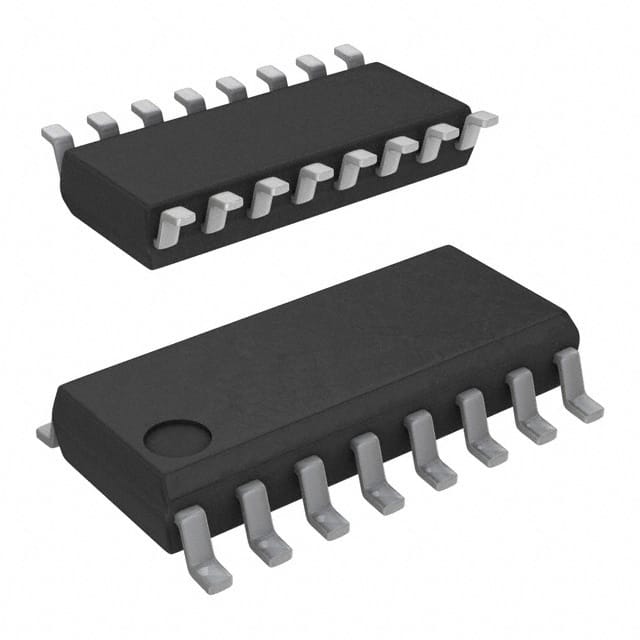CD74HC138MG4
Product Overview
- Category: Integrated Circuit
- Use: Decoding and Demultiplexing
- Characteristics: High-Speed CMOS Logic, 3-to-8 Line Decoder/Demultiplexer
- Package: SOIC (Small Outline Integrated Circuit)
- Essence: The CD74HC138MG4 is a high-speed CMOS logic integrated circuit that functions as a 3-to-8 line decoder/demultiplexer. It is commonly used in digital electronics for decoding and demultiplexing applications.
- Packaging/Quantity: The CD74HC138MG4 is available in a standard SOIC package and is typically sold in reels or tubes containing multiple units.
Specifications
The CD74HC138MG4 has the following specifications:
- Supply Voltage Range: 2V to 6V
- High-Level Input Voltage: 2V
- Low-Level Input Voltage: 0.8V
- High-Level Output Voltage: VCC - 0.5V
- Low-Level Output Voltage: 0.1V
- Maximum Operating Frequency: 50MHz
- Propagation Delay Time: 13ns
- Operating Temperature Range: -40°C to +85°C
Pin Configuration
The CD74HC138MG4 has a total of 16 pins, which are assigned specific functions as follows:
- GND: Ground
- A0: Address Input 0
- A1: Address Input 1
- A2: Address Input 2
- E1: Enable Input 1
- E2: Enable Input 2
- E3: Enable Input 3
- Y0: Output 0
- Y1: Output 1
- Y2: Output 2
- Y3: Output 3
- Y4: Output 4
- Y5: Output 5
- Y6: Output 6
- Y7: Output 7
- VCC: Supply Voltage
Functional Features
The CD74HC138MG4 offers the following functional features:
- Decodes a 3-bit binary address to one of eight outputs
- Demultiplexes a single input line into eight separate output lines
- High-speed operation with minimal propagation delay
- CMOS technology ensures low power consumption and high noise immunity
- Wide supply voltage range allows for compatibility with various systems
Advantages and Disadvantages
Advantages of the CD74HC138MG4 include:
- Fast decoding and demultiplexing capabilities
- Low power consumption
- High noise immunity
- Wide supply voltage range
Disadvantages of the CD74HC138MG4 include:
- Limited number of address inputs (3 bits)
- May require additional circuitry for complex applications
Working Principles
The CD74HC138MG4 operates based on the principles of digital logic. It uses the three address inputs (A0, A1, A2) to select one of the eight outputs (Y0-Y7) based on the binary value applied to the address inputs. The enable inputs (E1, E2, E3) control the operation of the decoder/demultiplexer.
When the enable inputs are active (typically set to a logical high), the selected output is determined by the binary value applied to the address inputs. When the enable inputs are inactive (logical low), all outputs are in a high-impedance state.
Detailed Application Field Plans
The CD74HC138MG4 finds applications in various fields, including:
- Address decoding in microcontrollers and microprocessors
- Memory selection and control in digital systems
- Data demultiplexing in communication systems
- Signal routing and selection in audio/video equipment
- Control logic in industrial automation systems
Detailed and Complete Alternative Models
Some alternative models that offer similar functionality to the CD74HC138MG4 include:
- 74LS138: Low-power Schottky TTL 3-to-8 line decoder/demultiplexer
- CD4017: CMOS decade counter/divider with 10 decoded outputs
- SN74HC238: High-speed CMOS 3-to-8 line decoder/demultiplexer
These alternative models can be considered based on specific requirements, such as power consumption, operating voltage range, or additional features.
In conclusion, the CD74HC138MG4 is a high-speed CMOS logic integrated circuit used for decoding and demultiplexing applications. It offers fast operation, low power consumption, and wide compatibility. Its pin configuration, functional features, advantages, and disadvantages make it suitable for various digital electronics applications.
Senaraikan 10 soalan dan jawapan biasa yang berkaitan dengan aplikasi CD74HC138MG4 dalam penyelesaian teknikal
Sure! Here are 10 common questions and answers related to the application of CD74HC138MG4 in technical solutions:
Q: What is CD74HC138MG4? A: CD74HC138MG4 is a 3-to-8 line decoder/demultiplexer integrated circuit (IC) that can be used in various digital logic applications.
Q: What is the purpose of CD74HC138MG4? A: The purpose of CD74HC138MG4 is to decode a binary input and select one of the eight output lines based on the input value.
Q: What voltage levels does CD74HC138MG4 support? A: CD74HC138MG4 supports voltage levels ranging from 2V to 6V, making it compatible with both TTL and CMOS logic families.
Q: How many inputs does CD74HC138MG4 have? A: CD74HC138MG4 has three binary inputs (A0, A1, and A2) that determine which output line is selected.
Q: How many output lines does CD74HC138MG4 have? A: CD74HC138MG4 has eight output lines (Y0-Y7), allowing for selection of one out of eight possible outputs.
Q: Can CD74HC138MG4 be cascaded to increase the number of output lines? A: Yes, multiple CD74HC138MG4 ICs can be cascaded together to increase the number of output lines and enable larger decoding capabilities.
Q: What is the maximum current that CD74HC138MG4 can source or sink? A: CD74HC138MG4 can source or sink up to 4mA of current per output pin.
Q: What is the propagation delay of CD74HC138MG4? A: The typical propagation delay of CD74HC138MG4 is around 13ns, making it suitable for high-speed applications.
Q: Can CD74HC138MG4 be used in both active-high and active-low configurations? A: Yes, CD74HC138MG4 can be used in both active-high and active-low configurations by appropriately connecting the enable (E) pin.
Q: What are some common applications of CD74HC138MG4? A: CD74HC138MG4 is commonly used in address decoding, memory selection, data routing, and general-purpose digital logic circuits.
Please note that these answers are general and may vary depending on specific datasheet specifications and application requirements.


